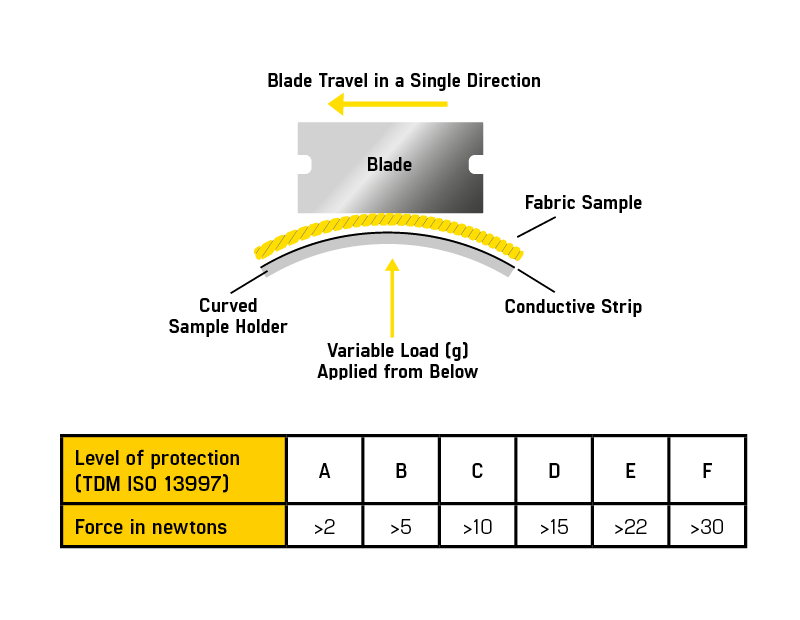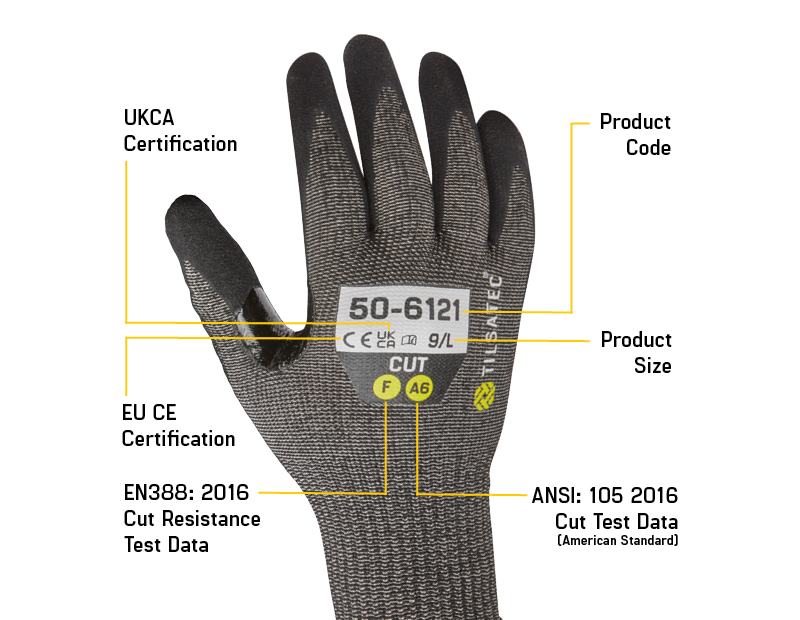What is the difference between EN ISO 13997 and EN 388 cut resistance tests?
EN 388 references two different test methods: blade cut resistance, ie the “coupe” test and the ISO 13997 cut resistance test.
EN 388 blade cut resistance: The Coupe Test determines a material’s cut resistance rating by counting the rotations needed for a circular blade to cut through the material laterally. The score is based on the ratio of rotations it takes to cut through the sample vs a control material. This test method is not recommended for gloves with a high level of cut resistance, as the materials within the glove, such as steel and glass, can dull the blade, resulting in inaccurate results.
This test uses a circular blade under a 5N load that moves in a backward and forward motion over the specimen until the blade cuts through. A “cutting index” is calculated, and a level from 1 to 5 is assigned.
EN ISO 13997 cut resistance: The test method is performed on a TDM machine and is fitted with a single-use straight edge blade that is drawn in a single direction across the material. The blade is replaced after each cut. A range of loads is used throughout the test, and the cutting distance against the force used (in Newtons) is plotted to determine the force required to cut through the material in a 20mm blade stroke. A number of cuts are being carried out to ensure a cutting distance range of between 5 and 50mm is achieved.
By using the blade only once and testing a variety of forces (as opposed to the sole 5N force used in the coupe test), the impact of blade blunting is eliminated, and a more accurate representation of cut protection is able to be assigned.

How is the test measured?
Performance levels are classified as A-F, with F being the highest.

Glove Markings
The glove markings on the back of the hand indicate to which standards the glove has been tested and the performance levels achieved for the relevant tests. Further information such as the CE mark, the pictogram for referring to user information, product codes and size designation is also present on the glove markings.

What factors influence the cut resistance of a glove?
The factors that influence cut resistance include the composition of the yarns, knitting structure, and glove coatings. High-performance fibres such as Dyneema, aramid fiber, and HPPE, as well as stainless steel, can be used to enhance strength, durability, and cut resistance.
The thickness, gauge, and blending of yarn can significantly impact the performance and level of protection offered by the glove.Why is it important to have high levels of cut resistance?
As specialists in cut protection, we understand the demand for this feature in industries across various sectors. Workers in multi-risk environments with heavy-duty equipment and dangerous work areas may require this protection if faced with cutting hazards.
Here are some examples of key sectors that heavily rely on cut-resistant hand protection.
Manufacturing
- Metalworking: Handling sheet metal, sharp edges, and burrs.
- Glass manufacturing: Protecting against glass shards and sharp edges.
- Automotive manufacturing: Working with metal components and sharp tools.
- Food processing: Handling knives, blades, and sharp equipment.
Construction
- General construction: Working with rebar, metal sheets, and sharp tools.
- Demolition: Handling debris, glass, and metal fragments.
Utilities
- Electrical and telecommunications: Handling cables, wires, and sharp tools.
Waste Management
- Recycling and waste processing: Handling sharp objects within waste materials.
The EN ISO 13997cut resistance test method is essential for accurately evaluating materials with high levels of cut protection. Unlike the EN 388 coupe test, which can be unreliable for materials that dull blades, EN ISO 13997 employs a single-use blade and varying force to provide a more precise measurement. By understanding the factors influencing cut resistance, such as yarn composition, knitting structure, and coatings, we have been able to develop gloves that offer workers in specialised industries high levels of hand protection.
Manufacturing
- Metalworking: Handling sheet metal, sharp edges, and burrs.
- Glass manufacturing: Protecting against glass shards and sharp edges.
- Automotive manufacturing: Working with metal components and sharp tools.
- Food processing: Handling knives, blades, and sharp equipment.
Construction
- General construction: Working with rebar, metal sheets, and sharp tools.
- Demolition: Handling debris, glass, and metal fragments.
Utilities
- Electrical and telecommunications: Handling cables, wires, and sharp tools.
Waste Management
- Recycling and waste processing: Handling sharp objects within waste materials.
The EN ISO 13997:1999 cut resistance test method is essential for accurately evaluating materials with high levels of cut protection. Unlike the EN 388 coup test, which can be unreliable for materials that dull blades, EN ISO 13997 employs a single-use blade and varying force to provide a more precise measurement. Understanding the factors influencing cut resistance, such as yarn type, knitting structure, and coatings, allows us to develop gloves that are designed to offer specialised protection for workers in industries requiring high levels of hand safety.





